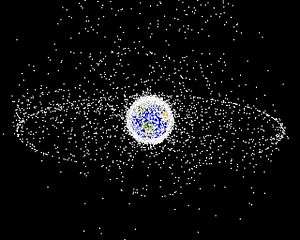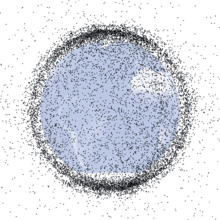Kessler syndrome

The Kessler syndrome (also called the Kessler effect,[1][2] collisional cascading or ablation cascade), proposed by the NASA scientist Donald J. Kessler in 1978, is a scenario in which the density of objects in low Earth orbit (LEO) is high enough that collisions between objects could cause a cascade—each collision generating space debris that increases the likelihood of further collisions.[3] One implication is that the distribution of debris in orbit could render space activities and the use of satellites in specific orbital ranges unfeasible for many generations.[3]
Debris generation and destruction
Every satellite, space probe, and manned mission has the potential to produce space debris. A cascading Kessler syndrome becomes more likely as satellites in orbit increase in number. As of 2014, there were about 2,000 commercial and government satellites orbiting the Earth.[4] It is estimated that there are 600,000 pieces of space junk ranging from 1 cm to 10 cm, and on average one satellite is destroyed each year.[4][5]
The most commonly used orbits for both manned and unmanned space vehicles are low Earth orbits, which cover an altitude range low enough for residual air drag to be sufficient to help keep the zone clear. Collisions that occur in this altitude range are also less of an issue because the directions into which the fragments fly and/or their lower specific energy often result in orbits intersecting with Earth or having perigee below this altitude.
Orbital decay is much slower at altitudes where atmospheric drag is insignificant. Slight atmospheric drag, lunar perturbation, and solar wind drag can gradually bring debris down to lower altitudes where fragments finally reenter, but this process can take millennia at very high altitudes.
Implications

The Kessler syndrome is especially insidious because of the "domino effect" and "feedback runaway" wherein impacts between objects of sizable mass spalls off debris from the force of collision. The shrapnel can then hit other objects, producing even more space debris: if a large enough collision or explosion were to occur, such as between a space station and a defunct satellite, or as the result of hostile actions in space, then the resulting debris cascade could make prospects for longterm viability of satellites in low earth orbit extremely low.[6][7] However, even a catastrophic Kessler scenario at LEO would pose minimal risk for launches continuing past LEO, or satellites traveling at medium Earth orbit (MEO) or GEO. The catastrophic scenarios predict an increase in the number of collisions per year, as opposed to a physically impassable barrier to space exploration which occurs in higher orbits.
Avoidance and reduction
Designers of a new vehicle or satellite are frequently required to demonstrate that it can be safely disposed of at the end of its life, for example by use of a controlled atmospheric reentry system or a boost into a graveyard orbit.[8] In order to obtain a license to provide telecommunications services in the United States, the Federal Communications Commission (FCC) requires all geostationary satellites launched after March 18, 2002, to commit to moving to a graveyard orbit at the end of their operational life.[9] U.S. government regulations require a boost, , of ~300 km.[10]
One technology proposed to help deal with fragments from 1 cm to 10 cm in size is the laser broom, a proposed multimegawatt land-based laser that could deorbit debris: the side of the debris hit by the laser would ablate and create a thrust that would change the eccentricity of the remains of the fragment until it would re-enter harmlessly.[11]
Potential trigger
The Envisat satellite is a large, inactive satellite with a mass of 8,211 kg (18,102 lb) that drifts at 785 km (488 mi), an altitude where the debris environment is the greatest—2 catalogued objects can be expected to pass within about 200 meters of Envisat every year[12]—and likely to increase. It could easily become a major debris contributor from a collision during the next 150 years that it will remain in orbit.[12]
In fiction
- Ken MacLeod's 1999 novel The Sky Road features an attempt to regain space-going capability following a Kessler syndrome catastrophe well before the book starts.
- The plot of 1999 manga and 2003 anime Planetes revolves around a crew in charge of disposal of debris to prevent further damage and destruction of spacecraft.
- The 2013 film Gravity features a Kessler syndrome catastrophe as the event that sets the plot in motion.[13]
- The plot of Neal Stephenson's 2015 novel Seveneves begins with the unexplained explosion of the Moon into seven large pieces, the subsequent creation of a cloud of debris by Kessler syndrome collisions, and the eventual bombardment of Earth's surface by lunar meteoroids.[14]
- The space flight simulation video game Kerbal Space Program loading screen randomly displays the loading hints "Treating Kessler Syndrome" and "Kesslerizing Kerbin". [15][16]
See also
- 1985 ASM-135 ASAT anti-satellite missile test
- 2007 Chinese anti-satellite missile test
- 2009 satellite collision
- P78-1
- SNAP-10A
- Space Liability Convention
References
- ↑ "Scientist: Space weapons pose debris threat – CNN". Articles.cnn.com. 2002-05-03. Retrieved 2011-03-17.
- ↑ "The Danger of Space Junk – 98.07". Theatlantic.com. Retrieved 2011-03-17.
- 1 2 Donald J. Kessler and Burton G. Cour-Palais (1978). "Collision Frequency of Artificial Satellites: The Creation of a Debris Belt". Journal of Geophysical Research. 83: 2637–2646. Bibcode:1978JGR....83.2637K. doi:10.1029/JA083iA06p02637.
- 1 2 "Lockheed Martin in space junk deal with Australian firm". BBC News. 28 August 2014. Retrieved 2014-08-28.
- ↑ Carpineti, Alfredo (2016-05-15). "Space Debris Has Chipped One Of The ISS's Windows". I Fucking Love Science. Archived from the original on 2016-05-16. Retrieved 2016-05-16.
- ↑ Primack, Joel R. (2002). "Debris and Future Space Activities" (PDF). Physics Department, University of California,.
With enough orbiting debris, pieces will begin to hit other pieces, setting off a chain reaction of destruction that will leave a lethal halo around the Earth.
- ↑ Joel R. Primack; Nancy Ellen Abrams. "Star Wars Forever? – A Cosmic Perspective" (PDF).
the deliberate injection into LEO of large numbers of particles as a cheap but effective anti-satellite measure.
- ↑ "FCC Enters Orbital Debris Debate". Archived from the original on 2008-05-06.
- ↑ "FCC Enters Orbital Debris Debate".
- ↑ "US Government Orbital Debris Standard Practices" (PDF).
- ↑ "NASA Hopes Laser Broom Will Help Clean Up Space Debris". SpaceDaily. Retrieved 2011-03-17.
- 1 2 Gini, Andrea (25 April 2012). "Don Kessler on Envisat and the Kessler Syndrome". Space Safety Magazine. Retrieved 2012-05-09.
- ↑ Sinha-Roy, Piya (July 20, 2013). "Gravity gets lift at Comic-Con as director Cuaron leaps into space". Reuters. Retrieved 2013-09-05.
- ↑ Freeman, Daniel (18 May 2015). "Neal Stephenson's Seveneves – A Low-Spoiler "Science" Review". Berkeley Science Review. Retrieved 4 August 2015.
- ↑ All loading hints can be seen on file \KSP_x64_Data\level0 inside default KSP installation. Current string offsets on file are 28992 and 29256, respectively.
- ↑ Squad's Bug Tracker contains a screenshot featuring that loading hint: Bug #7640: No loading bar, stuck on loading screen forever. - KSP Pre-Release - Squad Bugtracker. Retrieved November 29, 2016.
Further reading
- Kessler, D (2009). "The Kessler Syndrome (As Discussed by Donald J. Kessler)". Retrieved 2010-05-26.
- An article in the July 2009 issue of Popular Mechanics by Glenn Harlan Reynolds discusses the Kessler syndrome in regards to the February, 2009 satellite collision and how international law may need to address the problem to help prevent future incidents: Reynolds, G. H. (2009, July). Collision course. Popular Mechanics, p. 50-52.
- Kessler was featured in an article named, "The Looming Space Junk Crisis: It’s Time to Take Out the Trash," which appeared in the June 2010 issue of Wired Magazine.
- Documentary: Collision point: The race to clean up space (length: 22 minutes 28 seconds), included in the extra material on the Blu-ray Disc for Gravity (film).
External links
- Don Kessler's Web Page
- NASA Astronomy Picture of the Day: Satellites Collide in Low Earth Orbit (18 February 2009)
- Mathematical Modeling of debris flux
- New York Times: Orbiting Junk, Once a Nuisance, Is Now a Threat
- Wired: Houston we have a trash problem
- Schwartz, Evan I. (May 24, 2010). "The Looming Space Junk Crisis: It's Time to Take Out the Trash". Wired. Retrieved 14 June 2010.
- Debris Spews Into Space After Satellites Collide
- aggregated public information research on space debris, graveyard orbits, etc
- Associated Press: "Space junk littering orbit; might need cleaning up" (1 September 2011)